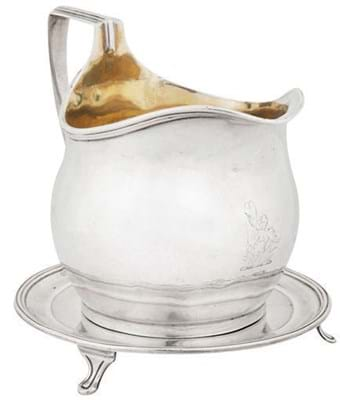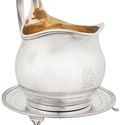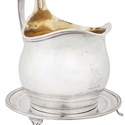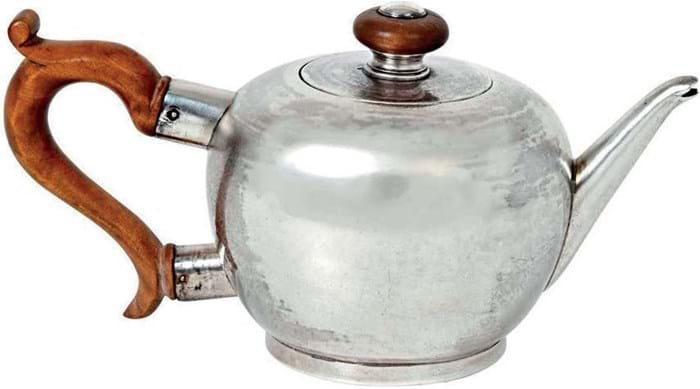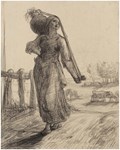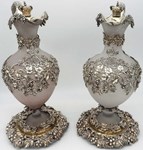The Assay Office in Norwich finally closed 1702, so secular objects that bear the city’s mark are rare.
Rarer still are pieces bearing the mark of the only woman silversmith registered in Norwich towards the end of that period.
One such piece is the William and Mary silver mug, dated for Norwich 1696, which came for sale at John Nicholson’s (25% buyer’s premium) in Fernhurst on March 16.
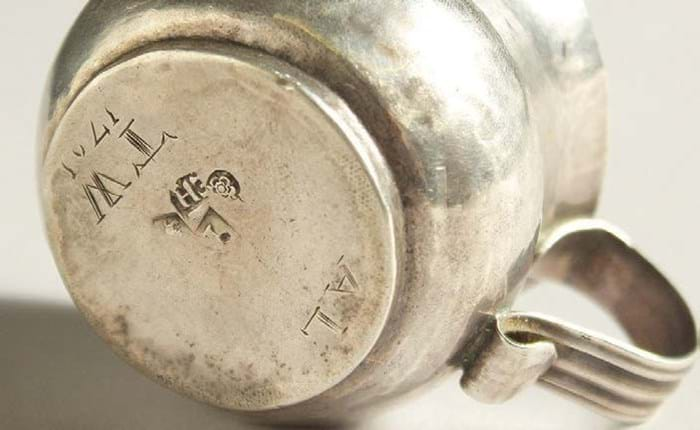
Norwich William and Mary silver mug by Elizabeth Haselwood, including a detail of the marks, £5800 at John Nicholson’s.
The EH to this William and Mary mug, struck for Norwich 1696, is the mark for Elizabeth Haselwood (1644- 1715), a member of the Haslewood family of silversmiths that prospered for three generations from around 1625-1740.
Elizabeth took over the workshop when her husband Arthur Haselwood II died in 1684. Then aged around 40, she ran the business – a large concern – until her death in 1715, probably hiring other smiths to complete the work. On her death the business passed to her son Arthur.
Examples of Elizabeth’s work include a c.1695 tobacco box in the collection of the National Museum of Women in the Arts and a c.1685 beaker in the Royal Collection.
The low estimate for this rare mug was £5000 and it did a little better, selling at £5800.
Elizabeth and her husband are buried in the same tomb in St Andrew’s Church, Norwich. A trefid spoon by Arthur Haslewood II dated 1676 sold for £3800 at Chiswick Auctions in London last October while back in 2007 Sworders sold a cannon-handled basting spoon by Elizabeth Haselwood, Norwich, 1697 for £4600.
York partnerships
Silver bearing York marks is relatively scarce as the assay office was open only briefly. Most pieces date from the Georgian and Victorian periods when, following an upturn in the fortunes of the silver trade in York, an assay office reopened there in 1776 and remained active until final closure in 1858.
As they catered for a relatively small market (at the time there were also assay offices in Newcastle and Sheffield), many of the silversmiths operated in partnerships.
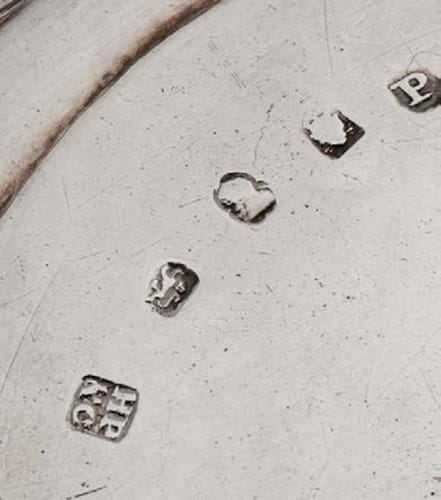
Pair of George III milk jugs or sauce boats on stands by Hampston, Prince and Cattle of York, including a detail of the marks, £4200 at Chiswick Auctions.
A pair of George III milk jugs or sauce boats on stands offered at Chiswick Auctions (25% buyer’s premium) on March 23 had marks for 1802 and the maker Hampston, Prince and Cattle for John Hampston, John Prince and George Cattle, the leading goldsmiths in Georgian York.
It is the survival of the stands that makes them so unusual.
The crest engraved to both jugs and stands is most likely for the Sykes family of Sledmere. A baronetcy was created in 1783 for Rev Mark Sykes (1711-83) with these pieces perhaps made for Mark Masterman Sykes (1771-1823) or his younger brother, Sir Tatton Sykes, 4th Baronet (1772-1863).
Estimated at £500-800, they took £4200 from a York collector.
Clonmel rarity
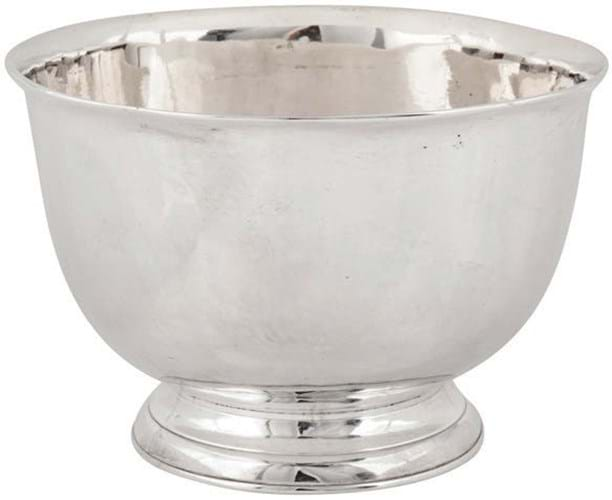
Irish provincial silver bowl with marks for Hercules Morgan of Clonmel, £3600 at Chiswick Auctions.
Although the market can wax and wane according to the desires of a relatively small group of (typically regional) enthusiasts, demand for provincial silver remains strong.
Also in this sale was a rare example of Irish provincial silver: a simple George II bowl made in Clonmel by Hercules Morgan around 1750. It had hopes of £600-800 but sold at £3600 online to an Irish collector.
Exceedingly few other pieces are known by Morgan including a coffee pot. He was related by marriage to the Cork silversmith Carden Terry (he married Jane Terry in February 1754) and is recorded as submitting plate for assay to Dublin in 1732, 1745 and 1752-55.
The previously unknown 6in (15cm) bowl was brought into Chiswick Auctions for identification by specialist John Rogers who has a reputation for identifying obscure or rare marks on silver.

Irish provincial silver bowl with marks for Hercules Morgan of Clonmel, £3600 at Chiswick Auctions.
Rogers explained the special allure of Irish Georgian silver made outside Dublin: “Irish provincial silver is a well sought-after field. Dublin is the usual, Cork is scarce, then there is a big jump in rarity for Limerick items.
"Thereafter silver made in places such as Galway, Youghal, Kinsale and Clonmel is so unbelievably rare it is almost mythical. In the case of Clonmel even most academics are not aware a silversmith worked there.”
For reasons of security and to save on duty, relatively little silver made in Ireland’s regional towns and cities was sent was to Dublin for official approval.
Instead, local silversmiths stamped their own wares with a maker’s mark and the word Sterling.
The appeal of Irish provincial silver lies primarily in the rarity, but it can also have a distinctive vernacular style that collectors admire.
Tyneside rarity
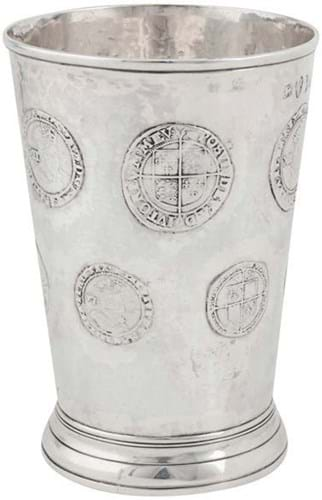
George III Newcastle silver coin beaker by John Langlands I and John Robertson, £1600 at Chiswick Auctions.
Sold to a US buyer at £1600 at Chiswick was a George III coin beaker made in Newcastle-upon Tyne.
The tradition of setting coins into beakers is a distinctly German one that was popular from the 17th to the 19th centuries. However, they are much more unusual in English silver.
This 5in (13cm) vessel carries the marks for 1782 and the Newcastle silversmiths John Langlands I and John Robertson. Langlands, the patriarch of the Langlands family who for 60 years were the largest silverplate producers in Newcastle, worked in partnership with John Robertson between 1778-95.
The hammered silver shillings and sixpence pieces coins they used to create this piece in the 1780s were all more than 150 years old at the time.
All are from the reign of Elizabeth I and James I.
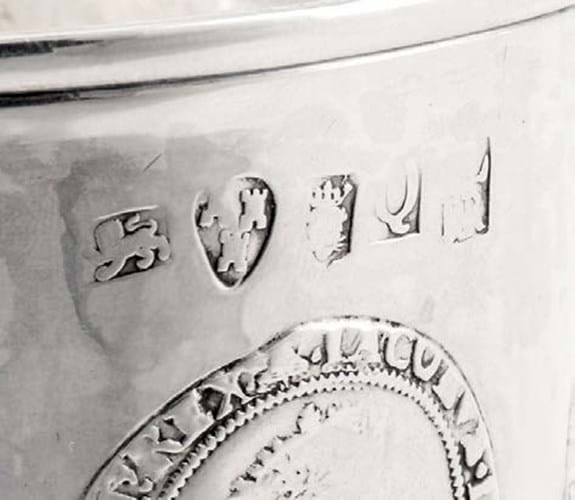
George III Newcastle silver coin beaker by John Langlands I and John Robertson, showing the marks, £1600 at Chiswick Auctions.
Rogers from Chiswick said: “Coins set to the bowls of English punch ladles are common, but this beaker is one of the few recorded Georgian silver hollowwares made in this way.
“One can speculate it was made in Newcastle on the wishes of a client who would have been familiar with pieces made in Germany.”
Francis Batty II (c.1680-1728) was among the most prominent silversmiths operating in Newcastle in the George I and George II period.
He took on many noticeable apprentices including the prolific Issac Cookson and George Hetherington, famous as he went to work in Jamaica.
Offered at Tennants (22% buyer’s premium) on March 18 was a bullet-shaped teapot by Batty with marks for Newcastle, 1721 and the lion passant facing right.
The right facing lion passant mark was a peculiarity of Newcastle silver in 1721 and 1723-27, the only other instance of a right-facing lion passant being used by an assay office is on York silver sporadically in the early 19th century.
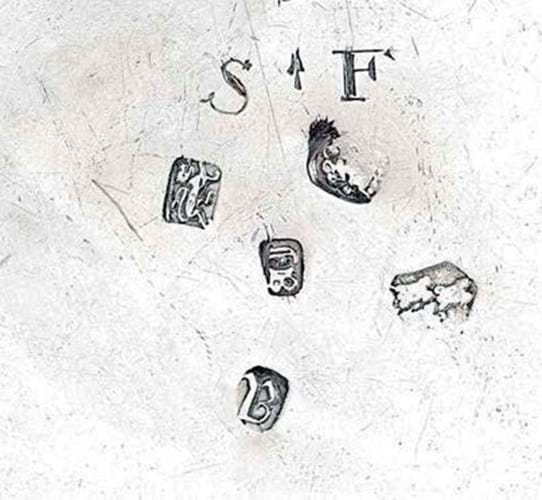
George II bullet-shaped teapot by Francis Batty II, including a detail of the marks, £4200 at Tennants.
This teapot, with wood handle and finial, had some condition issues but sold at £4200 (guide £1200-1800).
A tankard of the same date by Batty sold for £4200 at Chiswick Auctions in October 2020.




